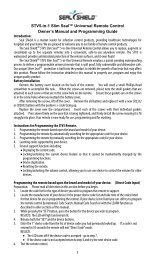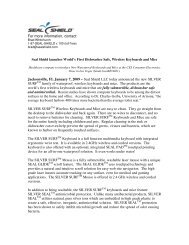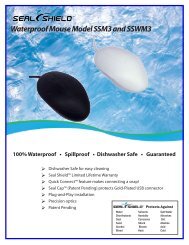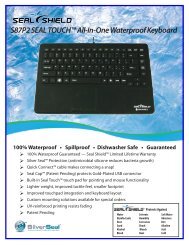Nanocrystalline silver dressings in wound management - Seal Shield
Nanocrystalline silver dressings in wound management - Seal Shield
Nanocrystalline silver dressings in wound management - Seal Shield
Create successful ePaper yourself
Turn your PDF publications into a flip-book with our unique Google optimized e-Paper software.
Fong and Wood<br />
nitrate 0.5% solution for burn <strong>wound</strong> treatment (Deml<strong>in</strong>g and<br />
DeSanti 2001; Dunn and Edwards-Jones 2004; Fong 2005).<br />
However, <strong>silver</strong> nitrate <strong>dress<strong>in</strong>gs</strong> are labour <strong>in</strong>tensive as they<br />
needed to be applied several times a day or re-moistened<br />
2 hourly. The potency of <strong>silver</strong> as an antimicrobial was<br />
found to be related to the amount and rate of free <strong>silver</strong><br />
released onto the <strong>wound</strong>bed (Lansdown 2002). In the late<br />
1960s, Fox <strong>in</strong>troduced <strong>silver</strong>sulfadiaz<strong>in</strong>e cream for burn<br />
<strong>wound</strong> <strong>management</strong>. This dramatically revolutionized the<br />
<strong>management</strong> of burn <strong>wound</strong>s by reduc<strong>in</strong>g the <strong>in</strong>cidence<br />
of burn <strong>wound</strong> <strong>in</strong>fections. Silversulfadiaz<strong>in</strong>e cream has a<br />
relatively short action, its penetration of the burn eschar<br />
is poor and it forms a pseudo-eschar. Both <strong>silver</strong> nitrate<br />
<strong>dress<strong>in</strong>gs</strong> and <strong>silver</strong>sulfadiaz<strong>in</strong>e cream require a high<br />
frequency of dress<strong>in</strong>g changes.<br />
Action of <strong>silver</strong><br />
Silver has antiseptic, antimicrobial, anti-<strong>in</strong>flammatory<br />
properties and is a broad spectrum antibiotic (Hoffman 1984;<br />
Klasen 2000; Deml<strong>in</strong>g and DeSanti 2001; Lansdown 2002;<br />
Dunn and Edwards-Jones 2004; Orv<strong>in</strong>gton 2004; Fong 2005).<br />
Silver is biologically active when it is <strong>in</strong> soluble form ie, as<br />
Ag + or Ag 0 clusters. Ag + is the ionic form present <strong>in</strong> <strong>silver</strong><br />
nitrate, <strong>silver</strong>sulfadiaz<strong>in</strong>e, or other ionic <strong>silver</strong> compounds.<br />
Ag 0 is the uncharged form of metallic <strong>silver</strong> present <strong>in</strong><br />
nanocrystall<strong>in</strong>e <strong>silver</strong> (Dunn 2004). Free <strong>silver</strong> cations<br />
have a potent antimicrobial effect which destroys microorganisms<br />
immediately by block<strong>in</strong>g the cellular respiration<br />
and disrupt<strong>in</strong>g the function of bacterial cell membranes. This<br />
occurs when <strong>silver</strong> cations b<strong>in</strong>d to tissue prote<strong>in</strong>s, caus<strong>in</strong>g<br />
structural changes <strong>in</strong> the bacterial cell membranes which <strong>in</strong><br />
turn cause cell death. Silver cations also b<strong>in</strong>d and denature<br />
the bacterial DNA and RNA, thus <strong>in</strong>hibit<strong>in</strong>g cell replication<br />
(Tredget et al 1998; Wright and Lam 1998; Y<strong>in</strong> et al 1999;<br />
Deml<strong>in</strong>g and DeSanti 2001; Lansdown 2002; Thomas 2003a,<br />
b; Dunn and Edwards-Jones 2004).<br />
Properties and action of<br />
nanocrystall<strong>in</strong>e <strong>silver</strong><br />
There are three types of nanocrystall<strong>in</strong>e <strong>wound</strong> products:<br />
Acticoat TM , Acticoat 7, and Acticoat Absorbent TM . Acticoat<br />
(Acticoat TM and Acticoat 7) are three or five layered dress<strong>in</strong>g<br />
constructs of a <strong>silver</strong> mesh conta<strong>in</strong><strong>in</strong>g <strong>silver</strong> nanocrystals<br />
applied to either side of a rayon/polyester core. <strong>Nanocrystall<strong>in</strong>e</strong><br />
<strong>silver</strong> utilizes nanotechnology to release clusters of extremely<br />
small and highly reactive <strong>silver</strong> particles (Smith and Nephew<br />
2003). The smaller the particles of <strong>silver</strong>, the greater the <strong>wound</strong><br />
surface area that will be <strong>in</strong> contact with <strong>silver</strong>, thus <strong>in</strong>creas<strong>in</strong>g<br />
bioactivity and <strong>silver</strong> solubility. Acticoat is made by a process<br />
called physical vapour deposition. Argon gas is <strong>in</strong>troduced<br />
<strong>in</strong>to a vacuum chamber act<strong>in</strong>g as an anode. When an electric<br />
current is passed <strong>in</strong>to the chamber, the argon ions knock out<br />
the <strong>silver</strong> atoms travell<strong>in</strong>g towards the substrate to be coated,<br />
deposit<strong>in</strong>g and develop<strong>in</strong>g nanocrystals each measur<strong>in</strong>g 15<br />
nanometres across and are between 30 and 50 atoms. These<br />
changes to the lattice structure of the crystal result <strong>in</strong> a high<br />
energy, meta-stable form of elemental <strong>silver</strong> (Dunn 2004).<br />
Acticoat when moistened with sterile water and placed<br />
on the <strong>wound</strong> releases clusters of highly reactive <strong>silver</strong><br />
cations up to 100 parts per million, caus<strong>in</strong>g electron transport,<br />
<strong>in</strong>activation of bacterial cell DNA, cell membrane damage<br />
and b<strong>in</strong>d<strong>in</strong>g of <strong>in</strong>soluble complexes <strong>in</strong> micro-organisms<br />
(Deitch et al 1987; Orv<strong>in</strong>gton 2001; Heggers et al 2002;<br />
Lansdown 2002; Dunn 2004). Acticoat releases 30 times less<br />
<strong>silver</strong> cations than other forms of <strong>silver</strong> such as 0.5% <strong>silver</strong><br />
nitrate or <strong>silver</strong>sulfadiaz<strong>in</strong>e. However, more of the <strong>silver</strong><br />
released is effective and release is susta<strong>in</strong>ed (Dunn 2004).<br />
If re-moistened, Acticoat produces a controlled release of<br />
clusters of <strong>silver</strong> cations onto the <strong>wound</strong>, for up to 3 days (if<br />
us<strong>in</strong>g Acticoat TM ) or 7 days (if us<strong>in</strong>g Acticoat 7). Research<br />
has demonstrated that susta<strong>in</strong>ed-release <strong>silver</strong> products<br />
have a bactericidal action provid<strong>in</strong>g effective <strong>management</strong><br />
of odor and exudate, thus reduc<strong>in</strong>g the risk for colonization<br />
and prevent<strong>in</strong>g <strong>in</strong>fection (Deitch et al 1987; Orv<strong>in</strong>gton 2001;<br />
Heggers et al 2002; Lansdown 2002; Smith and Nephew<br />
2003).<br />
Moisten<strong>in</strong>g Acticoat has a two-fold benefit: it unleashes<br />
the antimicrobial power of nanocrystall<strong>in</strong>e <strong>silver</strong> and assists<br />
<strong>in</strong> ma<strong>in</strong>ta<strong>in</strong><strong>in</strong>g a moist environment to promote <strong>wound</strong><br />
heal<strong>in</strong>g (Smith and Nephew 2003).<br />
Acticoat Absorbent TM is an alg<strong>in</strong>ate dress<strong>in</strong>g impregnated<br />
with nanocrystall<strong>in</strong>e <strong>silver</strong> crystals. It has an absorbent<br />
property when <strong>in</strong> contact with <strong>wound</strong> exudate and forms a<br />
gel and releases nanocrystall<strong>in</strong>e <strong>silver</strong> cations onto the <strong>wound</strong><br />
bed. Its antibacterial action is similar to that of Acticoat TM<br />
(Smith and Nephew 2004).<br />
Wound environment<br />
Controll<strong>in</strong>g micro-organisms with<strong>in</strong> a <strong>wound</strong> environment<br />
promotes <strong>wound</strong> heal<strong>in</strong>g. Micro-organisms, ie, bacteria or<br />
fungi are found <strong>in</strong> chronic <strong>wound</strong>s and if present <strong>in</strong> an acute<br />
<strong>wound</strong> can rapidly contam<strong>in</strong>ate and <strong>in</strong>fect, seriously imped<strong>in</strong>g<br />
<strong>wound</strong> heal<strong>in</strong>g. High levels of bacteria, multi-resistant<br />
organisms, and bacterial biofilms can impact on the <strong>wound</strong>-<br />
442<br />
International Journal of Nanomedic<strong>in</strong>e 2006:1(4)







